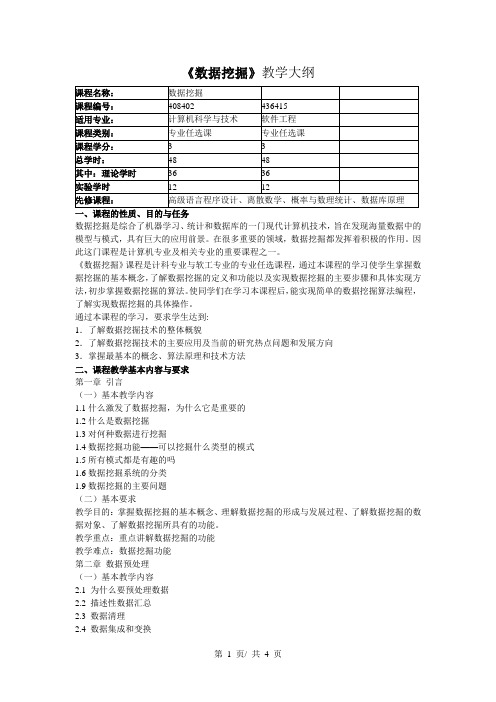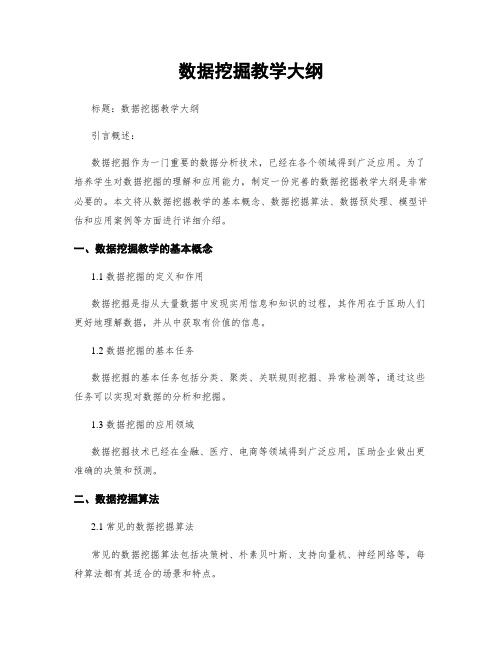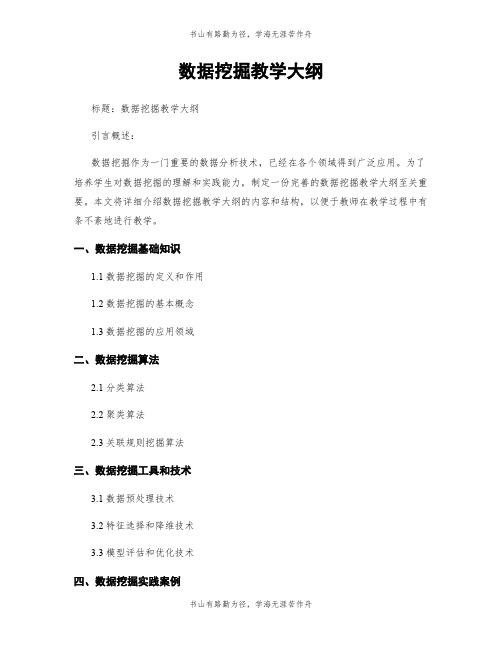《数据挖掘、机器学习和Weka》教学提纲
数据挖掘教学大纲

数据挖掘教学大纲一、课程简介数据挖掘是从大量数据中提取出有用信息的过程。
本课程旨在介绍数据挖掘的基本概念、方法和技术,培养学生的数据挖掘能力和解决实际问题的能力。
通过本课程的学习,学生将掌握数据挖掘的理论基础、常用算法和工具,能够应用数据挖掘技术解决实际问题。
二、课程目标1. 了解数据挖掘的基本概念和发展历程;2. 掌握数据挖掘的基本任务和常用方法;3. 熟悉数据预处理和特征选择的技术;4. 掌握常用的数据挖掘算法和模型,如分类、聚类、关联规则等;5. 学会使用数据挖掘工具进行实际数据挖掘项目的实施;6. 培养学生的数据分析和问题解决能力。
三、教学内容与安排1. 数据挖掘概述(2学时)1.1 数据挖掘的定义和发展历程1.2 数据挖掘的任务和应用领域1.3 数据挖掘的流程和方法2. 数据预处理(4学时)2.1 数据清洗2.2 数据集成2.3 数据变换2.4 数据规约3. 特征选择与降维(4学时) 3.1 特征选择的概念和方法 3.2 特征降维的概念和方法3.3 主成分分析(PCA)算法4. 分类与预测(6学时)4.1 分类与预测的概念和任务 4.2 决策树算法4.3 朴素贝叶斯算法4.4 支持向量机算法4.5 集成学习算法5. 聚类分析(4学时)5.1 聚类分析的概念和任务 5.2 K均值聚类算法5.3 层次聚类算法5.4 密度聚类算法6. 关联规则挖掘(4学时)6.1 关联规则挖掘的概念和任务6.2 Apriori算法6.3 FP-Growth算法7. 数据挖掘工具与实践(4学时)7.1 常用的数据挖掘工具介绍7.2 数据挖掘项目实施流程7.3 数据挖掘案例分析与实践四、教学方法与评价方式1. 教学方法本课程采用理论讲授和实践操作相结合的教学方法。
理论讲授部分通过课堂讲解、案例分析、小组讨论等方式进行;实践操作部分通过实验、项目实施等形式进行。
2. 评价方式本课程的评价方式包括平时成绩和期末考试。
《数据挖掘》教学大纲

《数据挖掘》教学大纲一、课程的性质、目的与任务数据挖掘是综合了机器学习、统计和数据库的一门现代计算机技术,旨在发现海量数据中的模型与模式,具有巨大的应用前景。
在很多重要的领域,数据挖掘都发挥着积极的作用。
因此这门课程是计算机专业及相关专业的重要课程之一。
《数据挖掘》课程是计科专业与软工专业的专业任选课程,通过本课程的学习使学生掌握数据挖掘的基本概念,了解数据挖掘的定义和功能以及实现数据挖掘的主要步骤和具体实现方法,初步掌握数据挖掘的算法。
使同学们在学习本课程后,能实现简单的数据挖掘算法编程,了解实现数据挖掘的具体操作。
通过本课程的学习,要求学生达到:1.了解数据挖掘技术的整体概貌2.了解数据挖掘技术的主要应用及当前的研究热点问题和发展方向3.掌握最基本的概念、算法原理和技术方法二、课程教学基本内容与要求第一章引言(一)基本教学内容1.1什么激发了数据挖掘,为什么它是重要的1.2什么是数据挖掘1.3对何种数据进行挖掘1.4数据挖掘功能——可以挖掘什么类型的模式1.5所有模式都是有趣的吗1.6数据挖掘系统的分类1.9数据挖掘的主要问题(二)基本要求教学目的:掌握数据挖掘的基本概念、理解数据挖掘的形成与发展过程、了解数据挖掘的数据对象、了解数据挖掘所具有的功能。
教学重点:重点讲解数据挖掘的功能教学难点:数据挖掘功能第二章数据预处理(一)基本教学内容2.1 为什么要预处理数据2.2 描述性数据汇总2.3 数据清理2.4 数据集成和变换2.5 数据归约2.6 数据离散化和概念分层产生(二)基本要求教学目的:了解数据预处理的原因,掌握数据预处理的方法。
教学重点:数据清理、数据集成和变换、数据归约、数据离散化和概念分层教学难点:数据归约、数据离散化和概念分层第三章数据仓库与OLAP技术概述(一)基本教学内容3.1 什么是数据仓库3.2 多维数据模型3.3 数据仓库的系统结构3.4 数据仓库实现3.5 从数据仓库到数据挖掘(二)基本要求教学目的:理解数据仓库的概念,了解数据仓库的多维数据模型,理解数据仓库的系统结构,掌握数据立方体的有效计算。
数据挖掘教学大纲

数据挖掘教学大纲一、引言1.1 课程背景数据挖掘是一门综合性学科,结合了统计学、机器学习、数据库技术等多个领域的知识和技术,旨在从大规模数据集中发现有价值的信息和模式。
1.2 课程目标本课程旨在培养学生对数据挖掘的基本概念、方法和技术的理解和应用能力,使其能够运用数据挖掘技术解决实际问题。
二、课程内容2.1 数据挖掘概述2.1.1 数据挖掘定义和基本任务2.1.2 数据挖掘过程和流程2.1.3 数据挖掘应用领域和案例介绍2.2 数据预处理2.2.1 数据清洗和去噪2.2.2 数据集成和转换2.2.3 数据规范化和归一化2.3 数据挖掘算法2.3.1 分类算法2.3.1.1 决策树算法2.3.1.2 朴素贝叶斯算法2.3.1.3 支持向量机算法2.3.2 聚类算法2.3.2.1 K均值算法2.3.2.2 层次聚类算法2.3.2.3 密度聚类算法2.3.3 关联规则挖掘算法2.3.3.1 Apriori算法2.3.3.2 FP-Growth算法2.4 模型评估和选择2.4.1 训练集和测试集划分2.4.2 交叉验证2.4.3 模型评估指标2.5 数据可视化2.5.1 数据可视化基本原理2.5.2 常用数据可视化工具和技术三、教学方法3.1 理论讲授通过课堂讲解,介绍数据挖掘的基本概念、方法和技术,以及相关的应用案例。
3.2 实践操作通过实验和案例分析,让学生实际操作数据挖掘工具和算法,加深对理论知识的理解和应用能力。
3.3 课堂讨论鼓励学生参预课堂讨论,分享自己的观点和经验,提高学生的思维能力和问题解决能力。
四、教学评价4.1 课堂表现考察学生课堂参预度、提问和回答问题的能力,以及对理论知识的理解程度。
4.2 实验报告要求学生完成一定数量的实验,并撰写实验报告,评估学生对数据挖掘算法和工具的实际应用能力。
4.3 期末考试考察学生对课程内容的整体掌握程度,包括理论知识和实际应用能力。
五、参考教材1. Han, J., Kamber, M., & Pei, J. (2022). Data mining: concepts and techniques. Morgan Kaufmann.2. Tan, P. N., Steinbach, M., & Kumar, V. (2022). Introduction to data mining. Pearson Education.六、教学资源1. 数据挖掘软件:如RapidMiner、Weka等2. 数据集:包括公开数据集和自行采集的数据集七、课程进度安排本课程共分为16周,每周2学时,具体进度安排如下:1. 第1-2周:引言和数据挖掘概述2. 第3-4周:数据预处理3. 第5-6周:分类算法4. 第7-8周:聚类算法5. 第9-10周:关联规则挖掘算法6. 第11-12周:模型评估和选择7. 第13-14周:数据可视化8. 第15-16周:复习和总结以上是关于数据挖掘教学大纲的详细内容。
数据挖掘教学大纲

数据挖掘教学大纲标题:数据挖掘教学大纲引言概述:数据挖掘作为一门重要的数据分析技术,已经在各个领域得到广泛应用。
为了培养学生对数据挖掘的理解和应用能力,制定一份完善的数据挖掘教学大纲是非常必要的。
本文将从数据挖掘教学的基本概念、数据挖掘算法、数据预处理、模型评估和应用案例等方面进行详细介绍。
一、数据挖掘教学的基本概念1.1 数据挖掘的定义和作用数据挖掘是指从大量数据中发现实用信息和知识的过程,其作用在于匡助人们更好地理解数据,并从中获取有价值的信息。
1.2 数据挖掘的基本任务数据挖掘的基本任务包括分类、聚类、关联规则挖掘、异常检测等,通过这些任务可以实现对数据的分析和挖掘。
1.3 数据挖掘的应用领域数据挖掘技术已经在金融、医疗、电商等领域得到广泛应用,匡助企业做出更准确的决策和预测。
二、数据挖掘算法2.1 常见的数据挖掘算法常见的数据挖掘算法包括决策树、朴素贝叶斯、支持向量机、神经网络等,每种算法都有其适合的场景和特点。
2.2 算法的原理和实现数据挖掘算法的原理是通过对数据进行建模和训练,从而得到预测模型,然后对新数据进行预测和分类。
2.3 算法的优化和改进为了提高数据挖掘算法的效果和准确性,研究者们向来在不断地优化和改进算法,使其更适合于实际应用场景。
三、数据预处理3.1 数据清洗数据清洗是数据挖掘的第一步,包括缺失值处理、异常值处理、重复值处理等,保证数据的质量和完整性。
3.2 数据集成数据集成是将多个数据源的数据整合在一起,消除数据的冗余和冲突,为后续的数据挖掘分析做准备。
3.3 特征选择特征选择是选择对建模和预测实用的特征,去除无关特征和噪声,提高模型的准确性和泛化能力。
四、模型评估4.1 模型评估指标模型评估指标包括准确率、召回率、F1值等,用于评估模型的性能和效果。
4.2 交叉验证交叉验证是一种常用的模型评估方法,通过将数据集分为训练集和测试集,多次训练和测试模型,得到更准确的评估结果。
数据挖掘教学大纲

数据挖掘教学大纲一、引言1.1 数据挖掘的概念和应用领域1.2 数据挖掘在实际问题中的作用和意义1.3 数据挖掘的基本流程和方法论二、数据预处理2.1 数据清洗2.1.1 缺失值处理2.1.2 异常值处理2.1.3 数据重复处理2.2 数据集成2.2.1 数据源选择2.2.2 数据集成方法2.3 数据变换2.3.1 数据规范化2.3.2 数据标准化2.3.3 数据离散化2.4 数据降维2.4.1 特征选择2.4.2 特征提取三、数据挖掘算法概述3.1 分类算法3.1.1 决策树算法3.1.2 支持向量机算法3.1.3 朴素贝叶斯算法3.1.4 K近邻算法3.1.5 集成学习算法3.2 聚类算法3.2.1 K均值算法3.2.2 层次聚类算法3.2.3 密度聚类算法3.3 关联规则挖掘算法3.3.1 Apriori算法3.3.2 FP-Growth算法3.4 异常检测算法3.4.1 离群点检测算法3.4.2 孤立森林算法四、数据挖掘模型评估和优化4.1 模型评估指标4.1.1 准确率4.1.2 召回率4.1.3 F1值4.1.4 ROC曲线和AUC值4.2 模型优化方法4.2.1 参数调优4.2.2 特征选择和降维4.2.3 集成学习方法五、实际案例分析5.1 电商推荐系统5.1.1 数据收集和预处理5.1.2 用户行为分析5.1.3 商品推荐算法实现5.2 社交媒体情感分析5.2.1 数据收集和预处理5.2.2 文本特征提取和情感分类5.2.3 结果可视化和分析六、数据挖掘工具和软件介绍6.1 常用数据挖掘工具6.1.1 Python中的Scikit-learn库6.1.2 R语言中的Caret包6.1.3 Weka工具6.2 数据可视化工具6.2.1 Tableau6.2.2 Power BI七、数据挖掘的伦理和隐私问题7.1 数据隐私保护7.1.1 匿名化技术7.1.2 脱敏处理7.2 数据共享和知识产权问题7.2.1 数据共享协议7.2.2 模型共享和商业化八、总结和展望8.1 数据挖掘的发展趋势8.2 数据挖掘在未来的应用前景以上是数据挖掘教学大纲的标准格式文本,详细描述了数据挖掘的基本概念、流程和方法,包括数据预处理、数据挖掘算法概述、模型评估和优化、实际案例分析、数据挖掘工具和软件介绍、数据挖掘的伦理和隐私问题等内容。
数据挖掘教学大纲

数据挖掘教学大纲
标题:数据挖掘教学大纲
引言概述:
数据挖掘作为一门重要的数据分析技术,已经在各个领域得到广泛应用。
为了培养学生对数据挖掘的理解和实践能力,制定一份完善的数据挖掘教学大纲至关重要。
本文将详细介绍数据挖掘教学大纲的内容和结构,以便于教师在教学过程中有条不紊地进行教学。
一、数据挖掘基础知识
1.1 数据挖掘的定义和作用
1.2 数据挖掘的基本概念
1.3 数据挖掘的应用领域
二、数据挖掘算法
2.1 分类算法
2.2 聚类算法
2.3 关联规则挖掘算法
三、数据挖掘工具和技术
3.1 数据预处理技术
3.2 特征选择和降维技术
3.3 模型评估和优化技术
四、数据挖掘实践案例
4.1 金融领域的数据挖掘实践
4.2 医疗领域的数据挖掘实践
4.3 社交网络领域的数据挖掘实践
五、数据挖掘伦理和法律问题
5.1 数据隐私保护
5.2 数据挖掘的伦理问题
5.3 数据挖掘的法律规范
结论:
通过本文对数据挖掘教学大纲的详细介绍,可以看出数据挖掘教学内容的丰富和多样性。
教师在设计和实施数据挖掘课程时,应该根据学生的实际情况和需求,灵活调整教学内容,使学生能够全面掌握数据挖掘的理论和实践技能,为将来的工作和研究打下坚实基础。
同时,也要重视数据挖掘的伦理和法律问题,引导学生正确处理数据挖掘过程中可能涉及的隐私和道德问题,做到合法合规地开展数据挖掘工作。
数据挖掘教学大纲

数据挖掘教学大纲数据挖掘教学大纲数据挖掘是一门涉及从大量数据中提取有用信息的技术。
随着信息时代的到来,数据挖掘在各个领域中扮演着重要的角色。
为了培养学生对数据挖掘的理解和应用能力,制定一份全面而系统的数据挖掘教学大纲至关重要。
一、引言数据挖掘是一门交叉学科,融合了统计学、机器学习和数据库等领域的知识。
本节将介绍数据挖掘的概念、发展历程以及在现实生活中的应用。
二、数据预处理数据预处理是数据挖掘的第一步,旨在处理原始数据中的噪声、缺失值和异常值等问题。
本节将介绍数据清洗、数据集成、数据变换和数据规约等预处理技术,并通过实例演示其应用。
三、数据挖掘任务数据挖掘任务包括分类、聚类、关联规则挖掘和时序模式挖掘等。
本节将详细介绍每个任务的定义、算法原理和实际应用,并通过案例分析帮助学生理解和掌握这些任务的实现方法。
四、特征选择与降维特征选择和降维是数据挖掘中的重要技术,可以帮助减少数据维度和提高模型性能。
本节将介绍特征选择的方法、特征降维的技术以及它们在实际问题中的应用。
五、模型评估与选择模型评估和选择是数据挖掘中的关键环节,它们可以帮助判断模型的性能和选择最优的模型。
本节将介绍常用的模型评估指标、交叉验证和网格搜索等技术,并通过实例演示如何评估和选择模型。
六、数据挖掘工具与平台数据挖掘工具和平台可以帮助学生更高效地进行数据挖掘实验和应用。
本节将介绍常用的数据挖掘工具和平台,如Weka、RapidMiner和Python的Scikit-learn等,并通过实例展示它们的使用方法。
七、伦理与隐私问题数据挖掘涉及到大量的个人隐私信息,因此在进行数据挖掘时必须考虑伦理和隐私问题。
本节将介绍数据挖掘中的伦理和隐私问题,以及相应的法律法规和道德准则。
八、数据挖掘案例研究本节将通过一些真实的数据挖掘案例研究,帮助学生将所学知识应用到实际问题中。
这些案例研究可以涵盖不同领域,如金融、医疗和电子商务等,让学生更好地理解和掌握数据挖掘的实际应用。
数据挖掘教学大纲

数据挖掘教学大纲标题:数据挖掘教学大纲引言概述:数据挖掘是一门涉及数据处理、分析和挖掘技术的重要学科,对于培养学生的数据分析能力和解决实际问题的能力具有重要意义。
因此,设计一份完善的数据挖掘教学大纲是非常必要的。
一、课程简介1.1 数据挖掘的定义和意义:介绍数据挖掘的概念及其在实际应用中的重要性。
1.2 课程目标:明确教学目标,包括培养学生的数据分析能力和解决实际问题的能力。
1.3 课程结构:概述课程的教学内容和安排,为学生提供清晰的学习路线。
二、基础知识2.1 数据预处理:介绍数据清洗、数据集成、数据转换和数据规约等基础知识。
2.2 数据挖掘算法:讲解常用的数据挖掘算法,如分类、聚类、关联规则挖掘等。
2.3 模型评估:介绍模型评估的方法和指标,如准确率、召回率、F1值等。
三、高级技术3.1 特征选择:讲解特征选择的方法和技巧,包括过滤式、包裹式和嵌入式特征选择。
3.2 集成学习:介绍集成学习的概念和常见方法,如Bagging、Boosting和随机森林等。
3.3 深度学习:简要介绍深度学习的原理和应用,包括神经网络、卷积神经网络和循环神经网络等。
四、实践案例4.1 数据挖掘工具:介绍常用的数据挖掘工具,如Weka、RapidMiner和Python 中的Scikit-learn等。
4.2 实际案例分析:通过真实数据集进行案例分析,让学生将理论知识应用到实际问题中。
4.3 课程项目:设计课程项目,让学生在实践中巩固所学知识,培养解决实际问题的能力。
五、评估与考核5.1 作业与考试:设计作业和考试,检验学生对数据挖掘知识的掌握程度。
5.2 课程评估:进行课程评估,采集学生反馈,不断改进教学内容和方法。
5.3 学习资源:提供学习资源和参考资料,匡助学生更好地学习和掌握数据挖掘知识。
结语:设计一份完善的数据挖掘教学大纲是为了匡助学生系统学习数据挖掘知识,培养其数据分析能力和解决实际问题的能力。
通过合理的课程设置和教学方法,可以提高学生的学习兴趣和学习效果,为他们未来的发展奠定良好的基础。
- 1、下载文档前请自行甄别文档内容的完整性,平台不提供额外的编辑、内容补充、找答案等附加服务。
- 2、"仅部分预览"的文档,不可在线预览部分如存在完整性等问题,可反馈申请退款(可完整预览的文档不适用该条件!)。
- 3、如文档侵犯您的权益,请联系客服反馈,我们会尽快为您处理(人工客服工作时间:9:00-18:30)。
数据挖掘(data Mining)
只是KDD/ML的一个重要组成部分。
DM用在产生假设 ,而OLAP则用于查证假设
概念:DM与DB
Data Preparation要占Data mining过程70%工作量 「Data base」+「 Data mining」=会说话的数据库
• Covering approach导出一个规则集而不是决策树
算法:The basic methods
Mining association rules:
– 参数:coverage(support),accuracy(confidence)
Linear models(参考cpu.arff例子)
简单例子:天气问题*
天气数据:weather.nominal.arff
运行Weka,载入数据,选择算法id3
预测(决策树)
• outlook = rainy
• | windy = TRUE: no
• | windy = FALSE: yes
测试方法:采用10 Cross-validation的
概念:Machine Learning
To learn:
– to get knowledge of study, experience, or being taught; – to become aware by information or from observation; – to commit to memory; – to be informed of, ascertain(确定); to receive instruction
– 不考虑类型,我们把要学习的称为Concept,而 把学习的输出成为concept description
Instance:数据样本记录 Attribute:数据字段
– Nominal:outlook: sunny => no – Ordinal:距离无法度量,如hot > mild > cool – Interval:距离可度量,如整数 – Ratio:如58.1%
Inferring rudimentary rules (算法:1R、1-Rule) Statistical modeling(算法:Naïve Bayes)
• 使用所有属性,假设属性无关、且同等重要
Divide and conquer: Constructing decision trees
– An open source framework for text analysis implemented in Java that is being developed at the University of Waikato in New Zealand.
– /ml/weka/ – /datamining/
Shortcomings when it comes to talking about computes
– It’s virtually impossible to test if learning as bean achieved or not.
– This ties learning to performance rather than knowledge
Getting to know your data!
• 数据清理一个耗时、费力,却很重要的过程, • Garbage in, garbage out!
输出:Knowledge representation
Decision tables Decision trees Classification rules
• If a and b then x
Association rules:多个结果
• If … then outlook=sunny and humidity=high
Rules with exceptions (P.66)
• If … then … except…else … except…
Trees for numeric prediction Instance-based representation Clusters
输入:Preparing the input*
Gathering the data together
– The data must be assembled, integrated, and cleaned up(Data Warehousing)
– Selecting the right type and level of aggregation is usually critical for success
概念:KDD、ML、OLAP与DM
KDD(Knowledge Discovery in Database)
是一种知识发现的一连串过程。
ML(Machine Learning)
=KD,不限于Database的数据 过程:挖掘-数据模式-表示-验证-预测 OLAP(Online Analytical Process)
Counting the cost:
• Lift charts (Respondents /Sample Size) 、ROC curves (P.141)
The MDL principle (Minimum Description Length)
• Occam’s Razor:Other things being equal, simple theories are preferable to complex ones.
回顾:DM的功能分类
分类方法一 分类(classification) 估计(estimation) 预测(prediction) 关联分组(affinity grouping) 聚类(clustering)
分类方法二 Classification Regression Time-Series Forecasting Clustering Association Sequence Discovery
– Metadata often involves relations among attributes
文本挖掘 挖掘Web
回顾:目录
DM综合的技术领域 DM的功能分类
DM的具体应用
DM的步骤
DM的理论技术和算法
DM的常用分析工具
回顾:DM综合的技术领域
Database systems, Data Warehouses, OLAP Machine learning Statistical and data analysis methods Visualization Mathematical programming High performance computing
其他算法:Neural Network
14.2857 %
数据挖掘的过程步骤:见『回顾:DM的步骤』
输入:Concepts, Instances, Attributes
Concept
– 四种基本的学习类型
• Classification, association, clustering, numeric prediction
测试结果:Confusion Matrix(P.138)和准确率
• a b <-- classified as
• 8 1 | a = yes
• 1 4 | b = no
• Correctly Classified Instances
12
85.7143 %
• Incorrectly Classified Instances 2
回顾:DM的具体应用
市场--购物蓝分析 • 保险欺诈侦察
客户关系管理
• 客户信用风险评级
寻找潜在客户
• 电话盗打
提高客户终生价值 • NBA球员强弱分析
保持客户忠诚度 • 信用卡可能呆帐预警
行销活动规划
• 星际星体分类
预测金融市场方向
回顾:DM的步骤*
一种步骤划分方式
– 理解资料与进行的工作 – 获取相关知识与技术(Acquisition) – 整合与查核资料(Integration and checking) – 去除错误、不一致的资料(Data cleaning) – 模式与假设的演化(Model and hypothesis development) – 实际数据挖掘工作 – 测试与核查所分析的资料(Testing and verification) – 解释与运用(Interpretation and use)
Support vector machines – Ch6.4 Instance-based learning – Ch6.5 Numeric prediction – Ch6.6 Clustering
改进:Engineering the input and output
数据工程
– Attribute selection – Discretizing(离散化) numeric attributes – Automatic data cleaning
原则:测试数据无论如何也不能用于模型的训练 问题:如果样本很少,如何划分? 方法:
• N-fold Cross-validation,(n=3,10) • Leave-one-out Cross-validation • Bootstrap (e=0.632): best for very small datasets
– 主要用于值预估和分类(Linear regression)
Instance-based learning
– 算法:Nearest-neighbor, K-Nearest-neighbor
